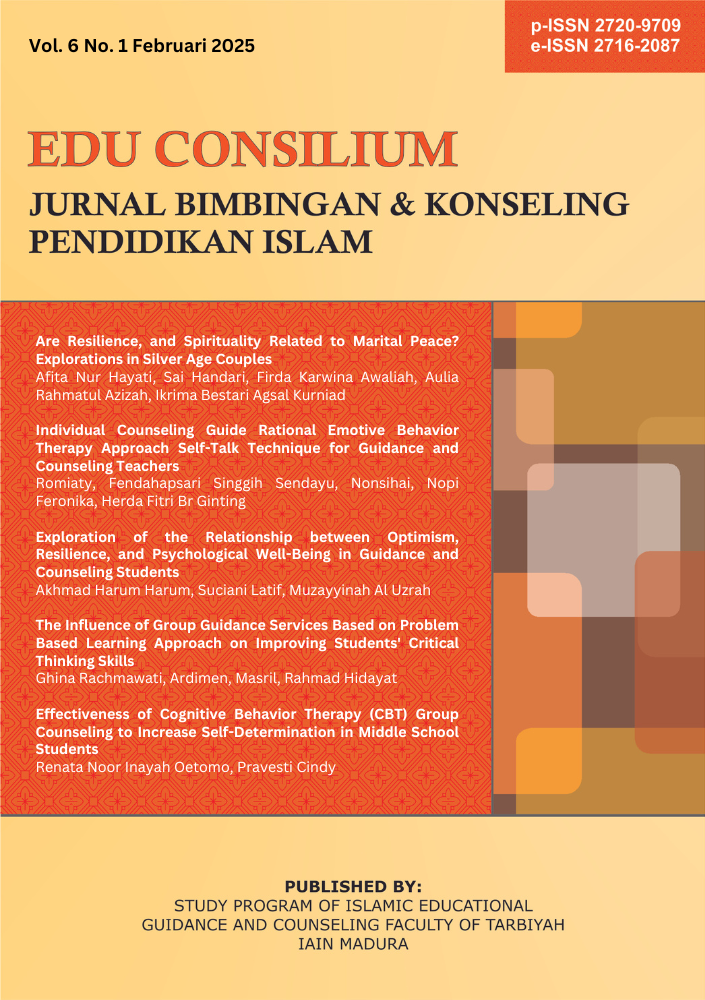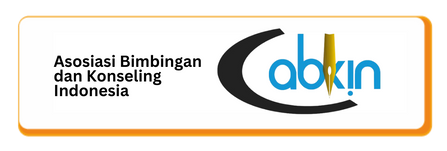Individual Counseling Guide Rational Emotive Behavior Therapy Approach Self-Talk Technique for Guidance and Counseling Teachers
 Abstract views: 81
,
Abstract views: 81
,
 PDF downloads: 102
PDF downloads: 102
Abstract
Individual counseling services are services to help solve student problems. One approach that can help students is the Rational Emotive Behavior Therapy (REBT) counseling approach, the Self-Talk technique. However, this approach is not used by Guidance and Counseling (BK) teachers; therefore, BK teachers in high school should have a complete guide to implement this approach. This research aims to develop an individual counseling guide using the REBT Self-Talk technique approach for high school guidance and counseling teachers in Palangka Raya. The research method in this study uses the development method or Research and Development (R&D). This development research procedure uses a 4D (four D) model, namely Define, Design, Development, Disseminate. The population of this study was high school guidance and counseling teachers in Palangka Raya City, totaling 30 people. Data collection techniques include interviews, questionnaires, and documentation. Data analysis techniques use quantitative and qualitative. The research results show that the guide has been validated and has received assessments from expert testers. Media experts with an accumulated feasibility value of 1,109 are calculated based on a high coefficient value, which means they are suitable for use. Material experts with an accumulated feasibility value of 0.945 are calculated based on the high coefficient values which is high, which means feasible. Practitioner experts have an accumulated feasibility value of 1.16 which is declared suitable for use. They have carried out a small group test with the calculated value resulting in an effect size of 0.904, so it can be concluded that the test has high effect criteria. The limitation of this research is that it was only tested on a small group and not on a large group.
Downloads
References
Aulia, I., & Nurjannah, N. (2023). Teori Klasik dan Kontemporer: REBT (Rational Emotif Behavior Therapy) hingga Positive Self talk Tinjauan Islam. ULIL ALBAB: Jurnal Ilmiah Multidisiplin, 2(4), 1376-1383.
Agustina, N. K. B. S., Gading, I. K., & Lestari, L. P. S. (2022). Pengembangan Perangkat Layanan Bimbingan Klasikal Untuk Meningkatkan Curiosity. Jurnal Bimbingan dan Konseling Indonesia, 7(1), 85-96. https://doi.org/10.23887/jurnal_bk.v7i1.1139
Corey, G. (2016). Theory and Practice of Counseling and Psychotherapy. Cengage Learning.
DiGiuseppe, R., Doyle, K. A., Dryden, W., & Backx, W. (2014). A practitioner's guide to rational-emotive behavior therapy (3rd ed.). New York: Oxford University Press.
Ellis, A. (2003). The relationship of rational emotive behavior therapy (REBT) to social psychology. Journal of rational-emotive and cognitive-behavior therapy, 21, 5-20.
Fakhriyani, D. V., Saâ, I., & Annajih, M. Z. (2021). Pendekatan REBT Melalui Cyber Counseling untuk Mengatasi Kecemasan di Masa Pandemi COVID-19. Counsellia: Jurnal Bimbingan dan Konseling, 11(1), 56-70. https://doi.org/10.25273/counsellia.v11i1.8463
Hariawan, R., & Sakti, H. G. (2021). Pengembangan Bahan Ajar Berbasis Ebook Pada Pelajaran TIK Untuk Siswa Kelas VII MTs Hidayatussibyan Nw Sangkerang. Jurnal Visionary: Penelitian Dan Pengembangan Dibidang Administrasi Pendidikan, 9(2), 66-74. DOI: https://doi.org/10.33394/vis.v9i2.4868
Indriyani, M., Suranata, K., & Lestari, L. P. S. (2022). Pengembangan panduan konseling rational emotive behavior therapy untuk mereduksi perilaku ketidakjujuran akademik pada siswa. Jurnal Bimbingan dan Konseling Indonesia, 7(1), 08-16. https://doi.org/10.23887/jurnal_bk.v7i1.1107
Jiyaunnajah, J., Hardiansyah, H., & Noorhidayati, N. (2023). Pengembangan Bahan Ajar Konsep Sistem Imun Di SMA Berbentuk E-Booklet. JUPEIS: Jurnal Pendidikan dan Ilmu Sosial , 2 (4), 179-189. https://doi.org/10.57218/jupeis.Vol2.Iss4.848
Khairunnisa, K., Sari, F. F., Anggelena, M., Agustina, D., & Nursa'adah, E. (2022). Penggunaan Effect Size Sebagai Mediasi dalam Koreksi Efek Suatu Penelitian. Jurnal Pendidikan Matematika: Judika Education, 5(2), 138-151. https://doi.org/10.31539/judika.v5i2.4802
Miftah, M. (2013). Fungsi, dan peran media pembelajaran sebagai upaya peningkatan kemampuan belajar siswa. Kwangsan: Jurnal Teknologi Pendidikan, 1(2), 95-105.
Muiz, M. R., & Fitriani, W. (2022). Urgensi Analisis Kebutuhan Dalam Pelayanan Bimbingan dan Konseling Di Sekolah. Jurnal Consulenza: Jurnal Bimbingan Konseling Dan Psikologi, 5(2), 116-126. https://doi.org/10.56013/jcbkp.v5i2.1378
Romiaty, dkk. (2023). Buku Ajar Teori Konseling REBT, Behavior dan Realita. Yogyakarta: Deepublish
Rosnawati, R., & Retnowati, E. (2013). LAPORAN TAHUNAN HIBAH BERSAING.
Sa'idah, I. (2019). Teori Dan Teknik Konseling. Pamekasan: IAIN Madura Press.
Sa’idah, I., & Annajih, M. Z. H. (2024). Konsep Dasar Bimbingan & Konseling. Pamekasan: Alifba Media.
Setyawan, F. H., & Eppendi, J. (2023). Developing Basic English Learning Material Based on Project Based Learning. In Social, Humanities, and Educational Studies (SHES): Conference Series (Vol. 6, No. 3).
Sugiyono. (2018). Metode Penelitian Kuantitatif,Kualitatif dan R&D. In ke-26.
Surur, M. (2021). A. Model Dick And Carey. Perencanaan Pembelajaran, 39.
Sweller, J. (2011). Cognitive load theory.
The journal operates an Open Access policy under a Creative Commons Non-Commercial 4.0 International license. Authors who publish with this journal agree to the following terms:
- Authors retain copyright and grant the journal right of first publication with the work simultaneously licensed under a
 Commons Attribution-NonCommercial 4.0 International License
Commons Attribution-NonCommercial 4.0 International Licensethat allows others to share — copy and redistribute the material in any medium or format, and adapt — remix, transform, and build upon the material.
- Authors are able to enter into separate, additional contractual arrangements for the non-exclusive distribution of the journal's published version of the work (e.g., post it to an institutional repository or publish it in a book), with an acknowledgement of its initial publication in this journal.
- Authors are permitted and encouraged to post their work online (e.g., in institutional repositories or on their website) prior to and during the submission process, as it can lead to productive exchanges, as well as earlier and greater citation of published work (see The Effect of Open Access).




















